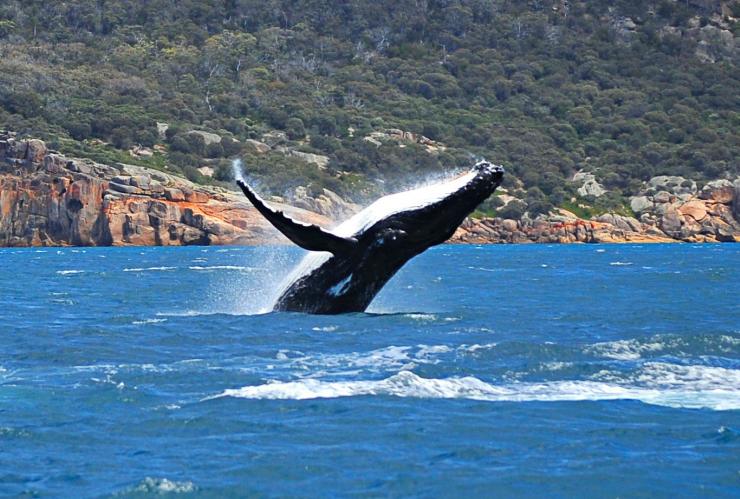
Head of Bight, South Australia © South Australian Tourism Commission
Whale watching in Australia
Spot southern right, dwarf minke, humpback whales and even orcas as they make their annual migration along Australia’s coasts.
The Australian coastline provides bountiful opportunities to observe any number of whale species on their annual migration. Spectators on both the east and west coasts have the chance to enjoy their own whale show, twice a year, as the mammals travel to and from Antarctica for what should be known as ‘the world’s longest lunch’ - feasting on all types of fish, krill, and plankton. At the tail-end of summer, they begin the long journey north to warmer waters for their breeding and birthing season, as young calves don’t yet have enough blubber on them to withstand the winter temperatures. Between May and November, you can spot southern right whales journeying to the temperate breeding waters off South Australia and Victoria, while energetic humpback whales continue north to the Great Barrier Reef and the Kimberley and orcas congregate off the southern coast of the state of Western Australia.
Here are the best spots around the country to take in their majestic beauty.
Near Hobart

Humpback whale in Schouten Passage, Freycinet Experience Walk, Freycinet National Park, Tasmania © Freycinet Experience Walk
When: May - July, September – December
Where: Legend has it that the residents of Hobart’s suburb of Taroona used to complain about being kept awake by the sounds of whales in the River Derwent. While whaling in the 19th century had a dramatic impact on the population, the whale numbers are recovering, and Tasmania’s east coast is still one of the best places to spot them on their annual migration. See humpback whales and southern right whales coasting through the clear waters of Great Oyster Bay off the Freycinet Peninsula, an area renowned for its pink granite cliffs and secret white beaches. Frederick Henry Bay is another great spot to grab a glimpse of the passing whales while still on dry land. Southern right whales and humpback whales often travel past the bay on the way to their breeding areas, but occasionally will stick around to give birth in Tassie, giving people the chance to see them from shore. You may also glimpse whales with their calves in Mercury Passage off Maria Island, a natural wildlife sanctuary.
How: Try a three-hour tour with Bruny Island Cruises to see whales taking shelter in Adventure Bay. Pennicott Wilderness Journeys also operate cruises and day tours from Hobart.
Near Perth

Killer whale, Naturaliste Charters, Bremer Canyon, Western Australia © Naturaliste Charters
When: June – November
Where: In Western Australia, the south coast is the best place for spotting whales. Humpback whales and southern right whales frolic in Augusta’s picturesque Flinders Bay (in the Margaret River wine region) from early June, and then watch Humpback Whale mother and their calves join bottlenose dolphins in Geographe Bay in Dunsborough in September. Further south, Albany’s rugged coastline makes another scenic grandstand as southern right whales take shelter in Albany's bays to mate and calve before returning south. Just under two hours east of Albany is Bremer Bay, home to one of the largest congregations of killer whales in the Southern Hemisphere. Head out on a research boat to spot them. Visitors to Albany can also learn about whales at the historic Whaling Station, an interactive museum built in the headquarters of the last whaling company to cease operations in Australia. From June to November, humpback whales can also be spotted travelling north-west to Broome (a 2.5-hour flight from Perth). And while Ningaloo Reef in Exmouth is famous for its swimming with the whale shark experience, it also sees the highest number of humpback whales in the Southern Hemisphere. Around 30,000 pass through Exmouth between June and November on their way to their birthing grounds off the Kimberley coast. A number of operators in the area offer small-group tours that allow you to swim with these incredible mammals.
How: Naturaliste Charters offer ocean adventures that depart from Albany, Augusta, Dunsborough, Busselton and Bremer Bay. Ningaloo Coral Bay Boats run a four-hour cruise out of Coral Bay, and Live Ningaloo offer a swim with humpback whale tour departing from Exmouth. Whale Watch Western Australia offer tours all year round, departing from Perth, Hillary's, Bremer Bay, Augusta, Albany, Dunsborough, Busselton and Margaret River.
Near Sydney

Humpback whale, Sydney, New South Wales © Rachelle Mackintosh, faunographic.com
When: May - late November
Where: Occasionally lucky Sydneysiders walking the famous Bondi to Coogee coastal track will catch a glimpse of passing humpbacks travelling north. The most common period is the last week of June and the first week of July. Then, in early September you’ll have another great chance of the mothers and calves passing by Sydney as they head back south. From land, Sydney’s best vantage point is The Gap at South Head in Watsons Bay. Outside of the city, head for Jervis Bay, a three-hour drive south of the city, where you're almost guaranteed a whale sighting in the calm, clear waters. The Shoalhaven Heads, Crookhaven Heads Lighthouse and Penguin Head at Culburra Beach offer great outlooks. Or hop onto one of the cruises leaving daily between May and November from Huskisson. Continue 3.5 hours further south to the coastal town of Merimbula on the beautiful Sapphire Coast, for both shore-based whale watching and charters. The town of Eden celebrates their arrival each year with the Eden Whale Festival, with live shows, a parade and local produce stalls. You can also see the same huge, graceful creatures from June in Byron Bay, playing just offshore from the Cape Byron Lighthouse.
How: Book a three-hour Discovery Cruise with Whale Watching Sydney from Circular Quay out into Sydney Harbour, where humpbacks make their way up the east coast. Jervis Bay Wild offers eco-cruises that leave from Huskisson and travel around Jervis Bay. Merimbula Marina offers regular whale watching cruises from May through to November with 100 per cent success rate.
Near Adelaide

Southern right whale and calf, Great Australian Bight, Eyre Peninsula, South Australia © South Australian Tourism Commission
When: June – September
Where: Victor Harbor, located 80 kilometres (49 miles) south of Adelaide, is a significant historic location for both the Ramindjeri people and the early colonial settlers alike who prized the area for its rich lands, sheltered waters and whales. Holiday goers now flock to the coastal destination to enjoy its clear turquoise waters and abundant wildlife, including the majestic southern right whales who come year on year to breed. Stand atop the steep cliffs around Victor Harbor’s Encounter Bay to watch these visitors frolic in the calm waters below. Or better yet, book a tour to see them play with their calves further out in the waters of the Fleurieu Peninsula. Further along South Australia’s jagged coastline in Ceduna, you can watch the whales do slow-motion somersaults from the viewing platform or beach.
How: The Big Duck Tour offers both group and chartered cruises that depart from Victor Harbor, Granite Island Causeway and Adelaide. Ceduna Tours will take you to the head of the Great Australian Bight Whale Sanctuary where you can get up close to southern right whales in their breeding ground near the towering Bunda Cliffs.
Near Brisbane

Whale watching, Harvey Bay, Queensland © Tourism and Events Queensland
When: May – November
Where: Queensland’s whale hot spot is at Hervey Bay, around 300 kilometres (186 miles) north of Brisbane. This tranquil spot is protected by K’gari (formerly Fraser Island), affording humpback whales the opportune location to hang around a while, either to mate, breed or nurse. To increase your chances of seeing the precious baby whales, time your visit around the first week of September. Each year in July and August, the arrival of the humpback whales is celebrated at the Hervey Bay Whale Festival, with concerts, street parades and displays. A bit further south, on the Sunshine Coast, adventure lovers can experience what it feels like to be part of a pod when they head out with Sunreef Mooloolaba to swim with humpbacks. If you keep travelling north until you reach the Whitsunday Islands, you can also get quite a show of humpback whales who tend to move into the area between May and September, enjoying the shallow, sheltered waters while they nurse their newborn calves. For a truly unforgettable experience, book in with one of the specialised operators to swim with dwarf minke whales. It is the only place in the world where people can dive with these highly intelligent, curious creatures and it only happens for a brief period in June and July. The encounters are always whale initiated and controlled, as swimmers are dropped into the appropriate area of water with their snorkels and instructed to hold onto a rope. The curious whales will then almost always come in for a closer look and have been known to spend hours swimming back and forth around divers, making eye contact and even bringing their calves for a look.
How: See the playful antics of the humpback whales aboard the Spirit of Hervey Bay, while legendary guide Vicky Neville from Tasman Ventures is often referred to as ‘the whale whisperer’. Mike Ball Dive Expeditions is one of the few lucky operators on the Great Barrier Reef who takes tour groups out to dive with the dwarf minke whales.
Near Melbourne

Whales, Warrnambool, Victoria © Visit Victoria
When: May – September
Where: Head to Logans Beach in Warrnambool, a three-hour drive out of Melbourne along the Great Ocean Road, and watch southern right whales calve in a nursery close to shore. They stay here for several weeks, helping their babies build strength for the long journey back to sub-Antarctic waters. You can capture the mother-and-calf interactions from the viewing platform on the sand dunes. Also try Lady Bay in Warrnambool, where the new mums often come close enough to spray you with breakwater. Travel a further 1.5 hours along the Great Ocean Road to see rare blue whales in their last feeding month at Cape Nelson near Portland.
How: Head to Logans Beach, located on Logans Beach Road off Hopkins Point Road, to find the specially designed viewing platform on the sand dunes. Bring your binoculars, and plan for multiple visits for your best chance at spotting the whales. Call the Visitor Information Centre beforehand for whale sighting updates.































































































































